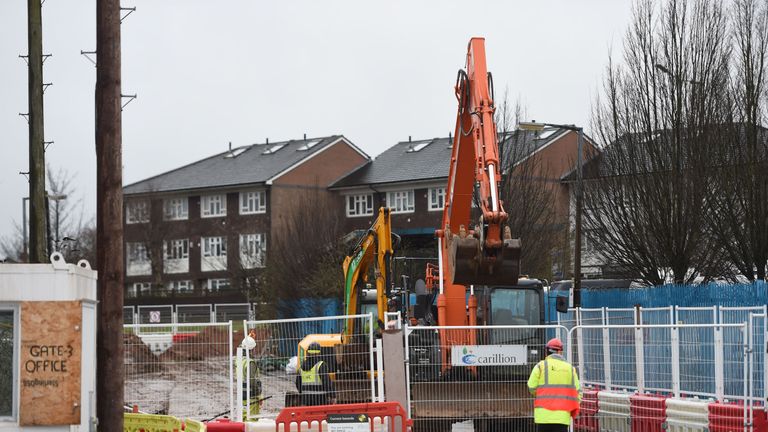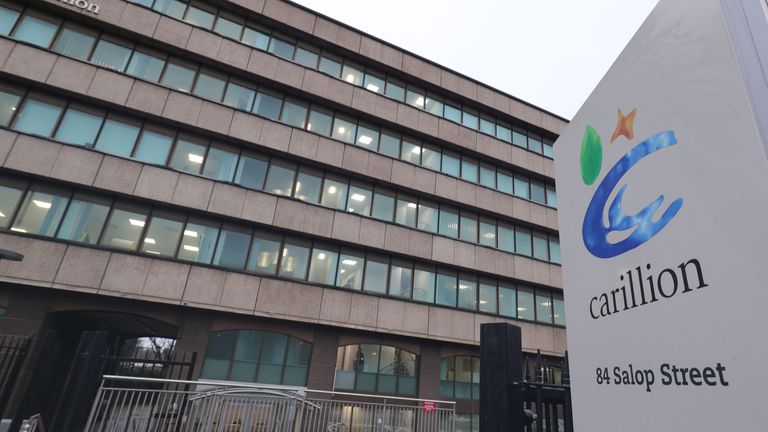What ultimately went wrong at Carillion
There were many warning signs ahead of the collapse of Carillion, with its management now firmly in focus, Sky's Ian King writes.
Tuesday 16 January 2018 12:55, UK
Carillion ultimately went under for the same reason every company goes under - it was overwhelmed by its debts and was unable to obtain further credit from its lenders.
Behind that, though, is the story of a company that was consistently too optimistic about the profitability of the work it was doing.
At the heart of that were cost overruns on major construction projects on which Carillion was working as a contractor for the Government: the £745m Aberdeen bypass, the £335m Royal Liverpool University Hospital and the £350m Midland Metropolitan Hospital at Smethwick near Birmingham.
:: Banks face £2bn loss from collapsed Carillion
There were specific difficulties with each of these three projects. In Liverpool, for example, asbestos was found on the brownfield site on which the new hospital was being built, high winds hampered the use of cranes and the discovery of cracks in the building also delayed completion.
In Aberdeen, low progress in completing initial earthworks pushed back the completion date. In Smethwick, there were problems with the ventilation, heating and lighting systems.
Contrary to what the unions often argue, Government contracts of these kind are not a licence to print money, but typically provide only wafer-thin profit margins for the contractors involved.
Because the work is done over a long period of time, the revenues they are likely to generate for the contractor are often little more than estimates at the time they bid for the contract, frequently making them subject to revision.
That was why, when on 10 July last year Carillion issued the first of three profits warnings, the company unveiled an astonishing provision of £845m - including some £599m worth of income it had previously expected to receive but no longer expected to.
:: How Carillion's demise could affect you
As Keith Cochrane, the respected engineering industry veteran who was parachuted in to try and rescue the company, said at the time: "Tenders have been accepted with a high degree of uncertainty about key assumptions; our ultimate success has been contingent on the performance of others not under our control and we've agreed design changes without agreeing incremental cost and value."
So this was a company that did not have a handle on its costs, was over-optimistic about the work it had taken on and had over-reached itself in terms of the projects it took on.
Delays in payments for work it had taken on in the Middle East added to its woes and getting out of contracts both there and in Canada added to strain on the balance sheet.
As the company's debts mounted, from around £695m in mid-2017 to an estimated £925m now, banks were reluctant to extend further credit to the company over and above the £140m that it raised from lenders - at a punishing rate of interest - in October last year.
Shareholders, it had been clear from July last year, were also reluctant to throw good money after bad. By the time of July's profits warning, rumours were already swirling around the City about Carillion's financial health.
Hedge funds have, for more than two years, been selling shares in Carillion in anticipation of the price falling lower.
They began digging into the company's accounts after it failed to pull off a merger with rival Balfour Beatty in 2014 and were further alerted to the company's financial plight when it lengthened its payment terms to suppliers to 120 days - always a sign that a company is trying to conserve cash.
The collapse of Carillion raises all kinds of questions, among which the most pressing is why both ministers and civil servants agreed to hand the company further work following July's profits warning.
Another is to whether Carillion kept the market properly updated on its financial situation, something into which the Financial Conduct Authority, the chief City regulator, is already looking, with a statement in December 2016 that said the company's performance was "meeting expectations" and that it expected "strong growth in total revenue and increased operating profits" looking particularly dubious.
A third question is why KPMG signed off on Carillion's 2016 report and accounts, published at the end of March last year, just months before the company issued its profits warning.
Then there are other questions about what this will mean for subcontractors used by the company and the other contractors with which they were working on larger projects.
Balfour Beatty, which was working with Carillion on three road projects including the Aberdeen bypass, has said the latter's failure will cost it between £35-£45m this year.
Pensioners, meanwhile, can expect a reduction in their retirement incomes when Carillion's 13 pension schemes are tipped into the Pension Protection Fund.
Other questions include the cost to the taxpayer: while the Government refused the bail out the company, it is still paying the cost of receivership, which will include the cost of re-tendering contracts.
This episode also raises questions about whether some public sector contracts on which Carillion was working, notably HS2, can be delivered at the price ministers have said they can.
Longer term, Carillion's collapse is likely to reignite a debate about whether the Government should be running all major infrastructure projects.
That seems unlikely, though: even before the birth of the Private Finance Initiatives so beloved by both major parties, the use of private sector contractors in projects such as roadbuilding was commonplace.
The Government cannot do everything - as the recent travails of the NHS have shown - while it interacts with the private sector in all other kinds of activity already anyway, whether that is in the supply of school, hospital and prison dinners, the provision of uniforms and equipment for the military, the cleaning of Government offices and the provision of IT services.
There is no logical reason why infrastructure work should be treated differently than these other activities.
And, if it was, there is no guarantee that it would be immune from the bad management of the kind that sank Carillion - which, potentially, would leave taxpayers facing the kind of hammering that creditors and shareholders have suffered during the last 18 months.






